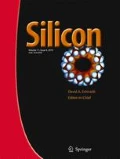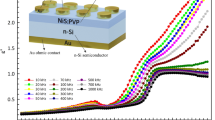Abstract
The frequency (10 - 107 Hz), temperature (303-363 K) or /and bias voltage (−2 to 2 V) dependence of the dielectric properties of Ni/SiO2/p-Si (MOS), have been investigated using the broadband dielectric spectrometer (BDS). Molecular structure and microstructure have been characterized using X - ray diffraction (XRD) and scanning electron microscope (SEM), respectively. From the experimental results, the capacitance–frequency (C-f) characteristics for MOS structure described as a series capacitance (Cs) in the oxide layer (SiO2) and a depletion layer in the semiconductor (p-Si). Interestingly, the capacitance over the whole frequency range for all temperatures are hardly distinguished particularly in the accumulation region, exploring enhancements of the electrical performance for MOS structure. Value of the flat band voltage (VFB) separating the accumulation and depletion regions was determinate at −0.5 V. Furthermore, thickness of the interfacial layer (SiO2) found to be ~580 Å. Both C and ε' found to be strongly temperature and frequency dependent particularly at high temperatures and low frequencies due to creation of an inhomogeneous layer at the SiO2/p-Si interface, exploring Maxwell-Wagner or interfacial polarization. Variation of ε' and ε'' with frequency revealed to the existence of surface states or traps (Nss) located at interfacial layer (SiO2), dipole or/and surface polarization. The average conductivity value of MOS structure found to be 1.2 × 10−7 S/cm, exploring semiconducting feature.
Similar content being viewed by others
References
Simon MS, Kwok KN (2007) Physics of semiconductor devices. John Wiley & Sons, New York
Seo YJ, Kim KC, Kim TG, Sung YM, Cho HY, Joo MS (2008) Analysis of electronic memory traps in the oxide-nitride-oxide structure of a polysilicon-oxide-nitride-oxide-semiconductor flash memory. Appl Phys Lett 92:132104
Har-Lavan R, Ron I, Thieblemont F, Cahen D (2009) Toward metal-organic insulator-semiconductor solar cells, based on molecular monolayer self-assembly on n-Si. Appl Phys Lett 94:043308
Lin CH, Liu CW (2010) Metal-insulator-semiconductor photodetectors. Sensors 10:8797–8826
Baraz N, Yücedağ İ, Azizian-Kalandaragh Y, Ersöz G, Orak İ, Altındal Ş, Akbari B, Akbari H (2017) Electric and dielectric properties of au/ZnS-PVA/n-Si (MPS) structures in the frequency range of 10–200 kHz. J Electron Mater 46:4276–4286
Nicollian EH, Brews J.R (1982) MOS physics and technology, John Wiley and Sons, New York
Chattopadhyay P, RayChaudhuri B (1993). Solid-State Elect 36:605–610
Büyükbaş Uluşan A, Tataroğlu A (2018) Frequency–dependent dielectric parameters of au/TiO2/nSi (MIS) structure. Silicon 10(5):2071–2077
Acar FZ, Buyukbas-Ulusan A, Tataroglu A (2018) Analysis of interface states in au/ZnO/p-InP (MOS) structure. J Mater Sci Mater Electron 29:12553–12560
Lin CH, Yeh WT, Chan CH, Lin CC (2012) Influence of graphene oxide on metal-insulator-semiconductor tunneling diodes, Nanoscale res. Lett 7:343
Afsal M, Wang CY, Chu LW, Ouyang H, Chen LJ (2012) Highly sensitive metal-insulator-semiconductor UV photodetectors based on ZnO/SiO2 core-shell nanowires. J Mater Chem 22:8420–8425
Malik A, Grimalsky V, Jacome AT, Durini D (2004) Theoretical modeling and experimental investigation of MIS radiation sensor with giant internal signal amplification, Sens. Actuators A Phys 114:319–326
Gomila G (1999) Effects of interface states on the non-stationary transport properties of Schottky contacts and metal-insulator-semiconductor tunnel diodes. J Phys D Appl Phys 32:64
Hudait KM, Krupanidhi SB (2000) Effects of thin oxide in metal-semiconductor and metal- insulator- semiconductor epi-GaAs Schottky diodes. Solid State Electron 44:1089–1097
Bayindir M, Sorin F, Abouraddy AF, Viens J, Hart SD, Joannopoulos JD (2004) Metal-insulator-semiconductor optoelectronic fibres. Nature 431:826–829
Saglam M, Ayyildiz E, Gümüs A, Türüt A, Efeoglu H, Tüzemen S (1996) Series resistance calculation for the metal-insulator-semiconductor schottky barrier diodes. Appl. Phys A 62:269–273
Kim H, Hong S-H, Chang Park Y, Lee J, Jeon C-H, Kim J (2014) Rapid thermal-treated transparent electrode for photodiode applications. Mater Lett 115:45–48
Asghar M, Mahmood K, Faisal M, Hasan MA (2013) Electrical characterization of au/ZnO/Si Schottky contact J. Physics, Conference Series 439:012030
Asar YS, Asar T, Altındal Ş, Özçelik S (2015) Dielectric spectroscopy studies and ac electrical conductivity on (AuZn)/TiO2/p-GaAs(110) MIS structures. Philos Mag 95:2885–2898
Bilkan Ç, Altındal Ş, Azizian-Kalandaragh Y (2017) Investigation of frequency and voltage dependence surface states and series resistance profiles using admittance measurements in Al/p-Si with Co3O4-PVA interlayer structures. Phys B Condens Matter 515:28–33
Nikravan A, Badali Y, Altındal Ş, Uslu I, Orak I (2017) On the frequency and voltage-dependent profiles of the surface states and series resistance of au/ZnO/n-Si structures in a wide range of frequency and voltage. J Electron Mater 46:5728–5736
Chand S, Kumar J (1996) Current transport in PdzSi/n-Si(l00) Schottky barrier diodes at low temperatures. Appl Phys A Mater Sci Process 63:171–178
Ashery A, Farag AAM, Mahani R (2010) Structural, electrical and magnetic characterizations of Ni/cu/p-Si Schottky diodes prepared by liquid phase epitaxy. Microelectron Eng 87:2218–2224
Thron AM, Greene PK, Liu K, Van Benthem K (2012) Structural changes suring the reaction of Ni thin films with (100) silicon substrates. Acta Mater 60:2668–2678
Lee P-H, Chang C-C (2007) Spectroscopic characterization of Ni films on sub-10-nm silica layers: thermal metamorphosis and chemical bonding. Surf Sci 601:362–375
Jain VV (2007) Microstructure and properties of copper thin films on silicon substrates MSc. A&M University, Texas
Chelkowski A (1980) Dielectric physics. Elsevier, Amsterdam
Popescu M, Bunget I (1984). Physics of Solid Dielectrics
Razouk R, Deal BJ (1979) Dependence of Interface state density on silicon thermal oxidation process variables. Electrochem Soc 126:1573 Elsevier, Amsterdam, pp.206-245, 82-291
Bentarzi H (2011) Transport in metal-oxide-semiconductor structures, engineering materials. Springer-Verlag, Berlin
Nicollian EH, Goetzberger A (1965) MOS conductance technique for measuring surface state parameters. Appl Phys Lett 7:216
Prabakar K, Narayandass SK, Mangalaraj D (2003) Dielectric properties of Cd0.6Zn0.4Te thin films. Phys Stat Sol (a) 199(3):507
Tataroğlu A, Yildirim M, Baran HM (2014) Dielectric characteristics of gamma irradiated au/SnO2/n-Si/au (MOS) capacitor. Mater Sci Semicond Process 28:89–93
Sengwa RJ, Dhatarwal P, Choudhary S (2015) Curr. Appl. Phys 15:135–143
Wagner RW (1914) Erklarung der dilectricshen-narchwirkugen auf grund maxwellscher vorstellungen. Arch Electrotech 2:371
Sillars RW (1937) The properties of dielectrics containing semiconducting particles various shapes. Inst Elect Eng 80:378
Sattar AA, Samy AR (2003) Dielectric properties of rare earth substituted cu–Zn ferrites. Phys Status Solidi A 200:415–422
Prabakar K, Narayandass Sa K, Mangalaraj D (2003) Dielectric properties of Cd0. 6Zn0. 4Te thin films. Phys Status Solidi A 199:507–514
Symth CP (1955) Dielectric behavior and structure. McGraw-Hill, New York
Ranga Raju MR, Choudhary RNP, Ram S (2003) Dielectric and electrical properties of Sr5EuCr3Nb7O30 nanoceramics prepared using a novel chemical route. Phys Stat Sol a 239:480
Singh V, Kulkarni AR, Rama Mohan TR (2003). J Appl Polym Sci 90:3602
Mazen SA, Zaki HM (2003) Effect of tetra ionic substitution on the dielectric properties of cu-ferrite. Phys Stat Sol (a) 199:305–320
Maurya D, Kumar J, Shripal (2005) Dielectric- spectroscopic and a.c. conductivity studies on layered Na2-XKXTi3O7 (X=0.2, 0.3, 0.4) ceramics. J Phys Chem Solids 66:1614–1620
Bengl S, Bülbül MM (2013) Electrical and dielectric properties of Al/HfO2/p-Si MOS device at high temperatures. Curr Appl Phys 13:1819–1825
Arslan E, Şafak Y, Taşçioğlu İ (2010) Frequency and temperature dependence of the dielectric and AC electrical conductivity in (Ni/au)/AlGaN/AlN/GaN heterostructures. Microelectron Eng 87:1997–2001
Dutta P, Biswas S, De SK (2002) Dielectric- relaxation in polyaniline–polyvinyl alcohol composites. Mater Res Bull 37:193–200
Bidault O, Goux P, Kchikech M, Belkaoumi M, Maglione M (1994) Space- charge relaxation in perovskites. Phys. Rev B 49:7868–7873
Abdel-wahab FA, Maksoud HM, Kotkata MF (2006) Electrical conduction and dielectric relaxation in semiconductor SeSm0.005. J Phys D Appl Phys 39:190–195
Sze SM (1981) Physics of semiconductor devices, second ed., John Wiley & Sons, New York
Jonscher A K (1980) Physics of Thin Films, edited by M. H. Francombe, Vol. 11, Academic Press, London and New York, 205
Jonscher AK (1977) The universal dielectric response. Nature 267:673–679
Funke K (1993). Prog. Solid -State Chem 22:111–195
Panigrahi SC, Piyush RD, Parida BN, Padhee R, Choudhary RNP (2014) Dielectric and electrical properties of gadolinium-modified lead-zirconate-titanate system. J Alloy Compd 604:73–82
Çetinkaya HG, Yıldırım M, Durmus P, Altındal S (2017) Diode - to-diode variation in dielectric parameters of identically prepared metal-ferroelectric-semiconductor structures. J. Alloy. Compd 728:896–901
Acknowledgements
The authors acknowledge the National Research Centre (NRC), Cairo, Egypt for supporting this work.
Author information
Authors and Affiliations
Corresponding author
Additional information
Publisher’s Note
Springer Nature remains neutral with regard to jurisdictional claims in published maps and institutional affiliations.
Rights and permissions
About this article
Cite this article
Mahani, R., Ashery, A. & Elnasharty, M.M.M. Frequency and Voltage Dependence of the Dielectric Properties of Ni/SiO2/P-Si (MOS) Structure. Silicon 12, 1879–1885 (2020). https://doi.org/10.1007/s12633-019-00277-4
Received:
Accepted:
Published:
Issue Date:
DOI: https://doi.org/10.1007/s12633-019-00277-4




